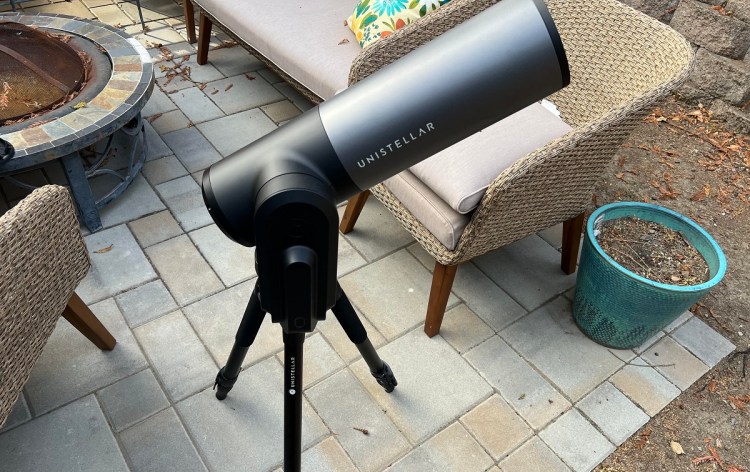Unlocking the Night Sky
Being an amateur astronomer from your own backyard has become remarkably accessible. Thanks to Unistellar, citizen science meets telescopes, granting us the ability to explore the celestial wonders of galaxies, star clusters, and nebulae, even in the midst of urban light pollution.
The magic lies in the fusion of machine learning and AI, which adeptly eliminates light pollution from images. This means you can now witness the marvels of the night sky without the need for remote, light pollution-free locations.
AI’s Impact on Everyday Products
This innovation underscores how AI is reshaping everyday products and expanding their capabilities. I recently confirmed this firsthand as I used Unistellar’s eQuinox 2 telescope to gaze at the night sky.
“Unistellar makes urban stargazing effortless.”
Unistellar, based in Marseilles, France, simplifies the process. You merely connect your smartphone to the telescope, empowering you to control its orientation and view the images directly on your phone’s screen.
Although the price tag of $2,500 may seem steep, the eQuinox 2 boasts an array of technology that enables this casual stargazing experience.
Telescope’s Technological Prowess
The eQuinox 2 impresses with its star database housing 37 million stars and its capability to observe over 5,000 celestial objects, including extensive star clusters. This far surpasses the limited potential of apps like Night Sky on your iPhone.
Unistellar ingeniously combines three cutting-edge technologies in one product:
- Smart Light Pollution Reduction: AI-driven technology eliminates background light pollution, enhancing image clarity.
- Enhanced Vision: Image processing expands the telescope’s range, providing clearer views of stars.
- Autonomous Field Detection: The telescope autonomously identifies celestial objects and your location.
Your smartphone delivers images at a resolution of 6.2 megapixels with a wide field of view. The telescope boasts a mirror diameter of 114 millimeters, an optical tube diameter of 144 millimeters, a focal length of 450 millimeters, and a total tube length of 549 millimeters.
Your Stargazing Companion
Transporting this telescope is akin to carrying a compact artillery piece. It comes in a backpack, and setup is relatively quick.
The tripod must be placed on level ground, guided by a built-in level indicator. Charging the telescope via a USB-C charger offers an operating time of 11 hours. Attaching the telescope to the tripod is a simple process, requiring only a couple of hand-turn screws.
Notably, there’s no traditional eyepiece for viewing. Instead, your smartphone connects via WiFi directly to the telescope, allowing you to observe and capture images on your device. This approach offers benefits such as easy updates via internet connectivity and the ability to connect up to 10 smart devices simultaneously, enabling a shared viewing experience.
From Parking Lot to Stargazing
Even in less-than-ideal conditions, Unistellar’s telescope can deliver remarkable results. During a viewing event near the San Francisco airport, where strong streetlamp lighting and brisk winds posed challenges, we managed to capture impressive images of celestial objects.
The telescope’s precise knowledge of its location on Earth ensures it can identify visible celestial objects at specific times. You can track stars and planets by inputting their precise coordinates.
Moreover, the “enhanced vision” mode further sharpens images by layering multiple captures over time, albeit with a brief processing delay. The telescope also offers a “visible sky area” filter to help you spot objects based on your location.
For instance, I observed the Hercules Globular Star Cluster, known as M13, which resides 22,000 light-years away and boasts a staggering 300,000 stars, each 12 billion years old. It’s awe-inspiring to ponder our insignificance in the face of such cosmic wonders, all visible from your backyard.
Astronomy for Everyone
Unistellar’s journey began in January 2017, propelled by a Kickstarter campaign that raised $2.5 million in November 2017. Their mission extends beyond crafting telescopes; it aims to rekindle the joy of astronomy, making it accessible to all. Unistellar encourages people to embrace astronomy as an integral part of their lives, demystifying the complexities often associated with stargazing.
Today, Unistellar boasts thousands of users worldwide who participate in the Citizen Science Network. They engage in collaborative missions, such as the DART Planetary Defense Drill and NASA’s Lucy Mission, contributing their images directly to scientific research.
Undoubtedly, experiencing another galaxy or a star cluster from your own backyard is a remarkable and accessible adventure—one I highly recommend.
“It should not be complicated.” – Franck Marchis, Chief Science Officer at Unistellar










